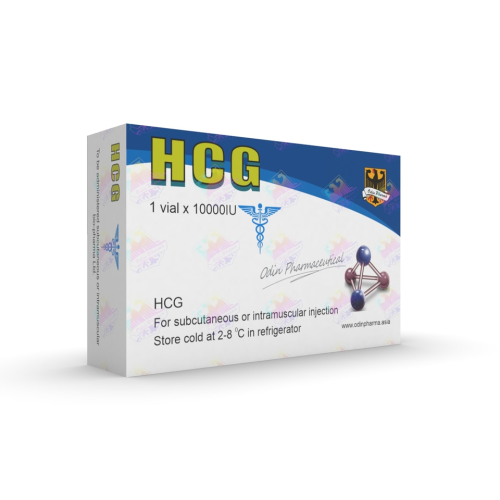Odin HCG 10000IU US
- Brand: Odin Pharma
- Product Code: Odin HCG 10000IU US
- Availability: In Stock
-
$144.00
- Active substance: Human Chorionic Gonadotropin
- Manufacturer: Odin Pharma
- Unit: 1vials (9999.99IU) HCGActive Substance: Human Chorionic GonadotropinOther Names: HCG, Gonado, Ovidrel, Pregnyl, PubergenActive Half-Life64 hours
Human Chorionic Gonadotropin (HCG) is a potent polypeptide hormone found in women during pregnancy. It is primarily utilized in medical treatments for conditions like cryptorchidism, female infertility, hypogonadism (low testosterone), and weight loss.
Additionally, HCG is commonly used by anabolic steroid users as a supplementary agent either while taking steroids or after they've stopped. The purpose of its use during steroid cycles is to mitigate hormonal suppression triggered by steroids. When used post-cycle, it assists in promoting a more efficient recovery process.
Effects of Gonadotropin:
A notable effect of HCG in contemporary practice is its use as a diet aid. The HCG diet has gained significant popularity in Western medicine, though its efficacy is often questioned. Organizations such as the American Medical Association and the American Society of Bariatric Physicians have criticized the HCG diet, pointing out that weight loss primarily results from the starvation commonly associated with it. HCG diets typically restrict caloric intake to just 500 calories per day. Analysis shows that HCG does not stimulate thyroid functions, act as a beta-2 stimulant, curb appetite, or exhibit traits related to thermogenic or fat-burning agents. While some doctors have reported successful outcomes with the HCG diet, the starvation aspect raises concerns about its health implications for sustained practice. Currently, there is insufficient evidence to confirm that weight loss attributed to the HCG diet would not occur without HCG alongside the same starvation regimen. The discussion surrounding this diet is likely to persist for many years.
The impact of HCG on users of anabolic steroids can be categorized into two phases: post-cycle therapy (PCT) and on-cycle use. Anabolic steroid consumption leads to the suppression of natural testosterone production, the extent of which depends on the specific steroids and dosages used, typically resulting in significant suppression. Once steroid use concludes, natural testosterone levels will gradually resume, assuming there was no pre-existing low testosterone issue or substantial damage to the HPTA during steroid use. Although production resumes, it is a slow process, leading to a period characterized by low testosterone levels and the associated symptoms. Such symptoms can be disruptive and result in the loss of muscle mass, as cortisol can become the dominant hormone in the absence of testosterone. Consequently, many steroid users adopt a PCT plan to help expedite recovery. While PCT does not restore testosterone levels to normal on its own, it facilitates sufficient testosterone for proper bodily functions as levels restore naturally.
Various PCT strategies exist, generally including selective estrogen receptor modulators (SERMs) such as Nolvadex (Tamoxifen Citrate) and/or Clomid (Clomiphene Citrate). However, many users find that initiating a PCT plan with HCG before introducing SERMs enhances overall recovery. In this regard, HCG acts like LH, preparing the body for subsequent SERM therapy to produce a more effective recovery.
The second beneficial role of HCG for anabolic steroid users is its application during steroid cycles. Steroid usage often leads to testicular atrophy due to suppressed natural testosterone levels. By supplementing with HCG, individuals may maintain fuller testicles. Although this cosmetic effect does not provide a strategic advantage, a potential benefit exists. Keeping the body supplied with exogenous LH can pave the way for smoother recovery after steroid use ends; however, there is a risk involved. The body can easily become dependent on HCG for its LH needs. While it doesn't develop a dependency on anabolic steroids, it can become reliant on HCG. For patients suffering from low testosterone and using HCG, this dependency isn't problematic. However, for individuals who are not low testosterone patients, careful regulation and monitoring of HCG use during cycles is essential to prevent LH dependency. Overzealous HCG use among anabolic steroid users has caused considerable harm, often exceeding the risk associated with steroid use alone. Though on-cycle usage can be advantageous in helping facilitate a more efficient recovery, responsible use is vital. Regardless of whether used during a cycle or as a precursor to PCT, HCG use must be carefully regulated.
Side Effects:For anabolic steroid users using HCG during cycles, a common practice is to administer 250iu every 4-5 days. This dosage is generally sufficient for the desired effects and should not be exceeded to ensure protection of future natural testosterone production.
Regarding PCT usage, there are two effective protocols. The first involves administering between 1,500-4,000iu every 3-4 days over a period of 2-3 weeks, then transitioning to SERM therapy. A second, potentially more effective method is to take HCG daily at a dose of 500-1,000iu for 10 consecutive days, followed by SERM therapy upon completion of this phase.
Timing is crucial if HCG is incorporated into PCT. If the last steroid injections were of any large ester-based steroids, HCG therapy should commence 10 days after the last injection, followed by SERM therapy once HCG has been completed. Conversely, if the cycle ended with small ester-based steroids, HCG therapy should start 3 days after the last injection, followed by SERM treatment once HCG use is finalized.

